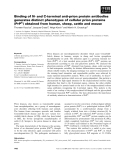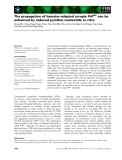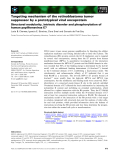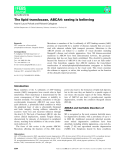
Cellular disorders
-
Prion diseases are neurodegenerative disorders which cause Creutzfeldt– Jakob disease in humans, scrapie in sheep and bovine spongiform encephalopathy in cattle. The infectious agent is a protease resistant iso-form (PrP Sc ) of a host encoded prion protein (PrP C ). PrP Sc proteins are characterized according to size and glycoform pattern.
 11p
11p  galaxyss3
galaxyss3
 21-03-2013
21-03-2013
 46
46
 4
4
 Download
Download
-
Transmissible spongiform encephalopathies (TSEs), or prion diseases, are fatal neurodegenerative disorders caused by an infectious agent termed a prion, which can convert normal cellular prion protein (PrP C ) into a patho-logically misfolded isoform (PrP Sc ). Taking advantage of protein misfolding cyclic amplification (PMCA), a series of experiments was conducted to investigate the possible influences of pyridine nucleotides on the propaga-
 10p
10p  vinaphone15
vinaphone15
 27-02-2013
27-02-2013
 40
40
 2
2
 Download
Download
-
The S100 proteins are 10–12 kDa EF-hand proteins that act as central reg-ulators in a multitude of cellular processes including cell survival, prolifera-tion, differentiation and motility. Consequently, many S100 proteins are implicated and display marked changes in their expression levels in many types of cancer, neurodegenerative disorders, inflammatory and autoim-mune diseases.
 13p
13p  viettel02
viettel02
 19-02-2013
19-02-2013
 34
34
 1
1
 Download
Download
-
DNA tumor viruses ensure genome amplification by hijacking the cellular replication machinery and forcing infected cells to enter the S phase. The retinoblastoma (Rb) protein controls the G1⁄S checkpoint, and is targeted by several viral oncoproteins, among these the E7 protein from human papillomaviruses (HPVs).
 16p
16p  mobifone23
mobifone23
 18-01-2013
18-01-2013
 38
38
 3
3
 Download
Download
-
Mutations to members of the A subfamily of ATP binding cassette (ABC) proteins are responsible for a number of diseases; typically they are associ-ated with aberrant cellular lipid transport processes. Mutations to the ABCA4 protein are linked to a number of visual disorders including Stargardt’s disease and retinitis pigmentosa.
 11p
11p  cosis54
cosis54
 04-01-2013
04-01-2013
 45
45
 3
3
 Download
Download
-
Abstract Intercellular signaling by cytokines is a vital feature of the innate immune system. In skin, an inflammatory response is mediated by cytokines and an entwined network of cellular communication between T-cells and epidermal keratinocytes. Dysregulated cytokine production, orchestrated by activated T-cells homing to the skin, is believed to be the main cause of psoriasis, a common inflammatory skin disorder.
 19p
19p  toshiba23
toshiba23
 18-11-2011
18-11-2011
 52
52
 2
2
 Download
Download
-
Stages of neutrophil development shown schematically. G-CSF (granulocyte colony-stimulating factor) and GM-CSF (granulocytemacrophage colony-stimulating factor) are critical to this process. Identifying cellular characteristics and specific cell-surface markers are listed for each maturational stage. Figure 61-3 Neutrophil band with Döhle body. The neutrophil with a sausage-shaped nucleus in the center of the field is a band form.
 4p
4p  konheokonmummim
konheokonmummim
 03-12-2010
03-12-2010
 77
77
 6
6
 Download
Download
-
Harrison's Internal Medicine Chapter 45. Azotemia and Urinary Abnormalities Azotemia and Urinary Abnormalities: Introduction Normal kidney functions occur through numerous cellular processes to maintain body homeostasis. Disturbances in any of these functions can lead to a constellation of abnormalities that may be detrimental to survival.
 8p
8p  ongxaemnumber1
ongxaemnumber1
 29-11-2010
29-11-2010
 86
86
 4
4
 Download
Download
-
Rational use of haematinic drugs is essential to the correction of anaemia in its various forms. The emergence of haemopoietic growth factors as drugs that stimulate erythroid or myeloid cell lines has opened the way to successful management of other forms of haematological disease. Iron: therapy, acute overdose Vitamin B12 (cobalamins) Folic acid Haemopoietic growth factors Sickle cell anaemia Polycythaemia rubra vera Aplastic anaemia 'colouring matter' of the blood and the 'defective nature of the colouring matter' in anaemia were recognised.
 15p
15p  bigbaby87
bigbaby87
 03-09-2010
03-09-2010
 102
102
 12
12
 Download
Download
CHỦ ĐỀ BẠN MUỐN TÌM






















